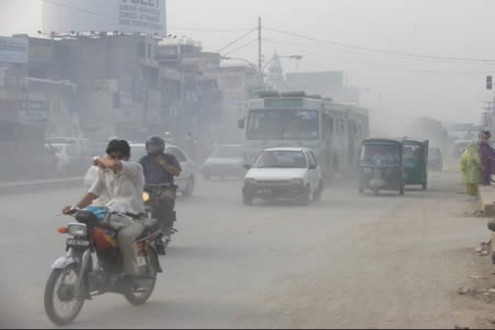Air pollution killed 1.23 lakh in Bangladesh in 2017
- Nayadiganta English Desk
- 04 April 2019, 11:42
South Asian child would be shortened on average by 30 months as they were growing up in current high levels of air pollution, study finds
Rising air pollution caused the deaths of minimum 1.23 lakh people in Bangladesh in 2017, a new study on global air pollution unveiled the information on Wednesday.
Both indoor and outdoor air pollution contributed to this death toll, study report entitled “State of Global Air-2019” pointed out the figure.
Two US based institutes Health Effects Institute (HEI) and Institute for Health Metrics and Evaluation (IHME) released the detailed report on quality of the global air with title.
It said the life of a South Asian child would be shortened on average by 30 months as they were growing up in current high levels of air pollution, private news agency United News Bangladesh quoted the report as saying.
The State of Global Air 2019, which used data from the period 1990 to 2017, estimated that if air pollution levels met the World Health Organisation (WHO) guidelines, life expectancy in Bangladesh would have seen the highest expected gain of nearly 1.3 years.
The report revealed that South Asia was the most polluted area in the world adding that worldwide, air pollution was responsible for more deaths than many better-known risk factors such as malnutrition, alcohol abuse and physical inactivity.
Air quality in Asia remained stubbornly poor, especially in Bangladesh the entire population has remained exposed to PM2.5 levels above 35 μg/m3 since 1990, according to the third annual State of Global Air report.
The study found that China and India together were responsible for over half of the total global attributable deaths, with each country witnessing over 1.2 million deaths from all air pollution in 2017. China has made initial progress, beginning to achieve air-pollution decline.
Out of these, 3 million deaths are directly attributed to PM2.5, half of which are from India and China together. The South Asian region — Bangladesh, India, Nepal and Pakistan — led the world as the most polluted, with over 1.5 million air-pollution related deaths according to the report.
Overall, long-term exposure to outdoor and indoor air pollution contributed to nearly 5 million deaths from stroke, diabetes, heart attack, lung cancer, and chronic lung disease in 2017.
Out of these, 3 million deaths are directly attributed to PM2.5, half of which are from India and China together. The South Asian region — Bangladesh, India, Nepal and Pakistan — led the world as the most polluted, with over 1.5 million air-pollution related deaths according to the report.
In 2017, air pollution was the fifth highest mortality risk factor globally and was associated with loss of 147 million years of healthy life, the report added.
“In 2017, annual PM2.5 exposures were highest in South Asia, where Nepal [100 μg/m3], India [91μg/m3], Bangladesh [61 μg/m3], and Pakistan [58 μg/m3] had the highest exposures,” it said.
The study found that 3.6 billion people (47% of the global population) were exposed to household air pollution from the use of solid fuels for cooking in 2017. These exposures were most common in sub-Saharan Africa, South Asia, and East Asia.
Kamruzzaman
More News
-
- ৫ঃ ৪০
- খেলা
-
- ৫ঃ ৪০
- খেলা


